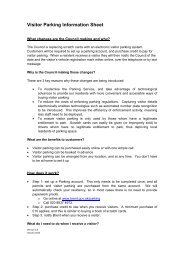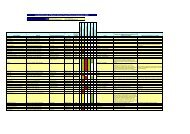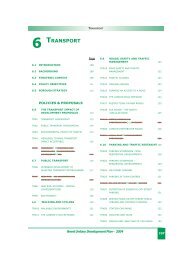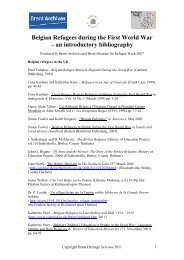Planning for Sport and Active Recreation Facilities ... - Brent Council
Planning for Sport and Active Recreation Facilities ... - Brent Council
Planning for Sport and Active Recreation Facilities ... - Brent Council
Create successful ePaper yourself
Turn your PDF publications into a flip-book with our unique Google optimized e-Paper software.
43<br />
<strong>Facilities</strong> <strong>Planning</strong> Model<br />
<strong>Sport</strong> Engl<strong>and</strong>’s <strong>Facilities</strong> <strong>Planning</strong> Model (FPM) provides<br />
a very comprehensive assessment of levels of supply <strong>and</strong><br />
dem<strong>and</strong> <strong>for</strong> <strong>Sport</strong>s halls <strong>and</strong> swimming pools only.<br />
The FPM allows an estimation of dem<strong>and</strong> across <strong>Brent</strong><br />
<strong>and</strong> our seven neighbouring boroughs (referred to as the<br />
Study Area). The Model uses current population statistics<br />
<strong>for</strong> all eight Boroughs <strong>and</strong> population projections <strong>for</strong> all<br />
in 2016. The current population statistics that the FPM<br />
have used is based on a population of 274,000 increasing<br />
to 293,400 in 2016, a conservative growth estimate of<br />
19,000 people (6.9% increase).<br />
Detailed current publicly accessible facility provision is<br />
included within the run data together with confirmed<br />
future publicly accessible facility provision <strong>for</strong> all eight<br />
Boroughs. A strategic modelling tool is then used to<br />
estimate the level of dem<strong>and</strong> <strong>for</strong> sports facilities within<br />
the local population, comparing this with the supply<br />
of facilities within a given local area. The model takes<br />
into account the size, age <strong>and</strong> location of the facilities<br />
<strong>and</strong> highlights any deficiencies in facility provision. The<br />
technique can also be used to model ‘what if’ scenarios,<br />
<strong>for</strong> instance, the impact of increases in population, the<br />
closure of individual facilities, <strong>and</strong> the opening of new<br />
facilities.<br />
The FPM estimates ‘dem<strong>and</strong>’ <strong>for</strong> a sport at the centroid<br />
of enumeration districts (EDS) based on participation<br />
rates <strong>and</strong> frequency per week in each of the 5/6 age<br />
b<strong>and</strong>s <strong>for</strong> both males <strong>and</strong> females, scaled down to the<br />
proportion of dem<strong>and</strong> in the peak period. This produces<br />
a figure <strong>for</strong> dem<strong>and</strong> at each EDS expressed in ‘visits per<br />
week in the peak period.’ For swimming pools there are<br />
six age b<strong>and</strong>s <strong>and</strong> five <strong>for</strong> sports halls <strong>for</strong> both males<br />
<strong>and</strong> females. These are considered with frequency <strong>and</strong><br />
duration of visit rates together with catchment (access by<br />
either car, foot or public transport) <strong>and</strong> a distance decay<br />
factor – which is all applied to the population.<br />
The FPM defines ‘unmet dem<strong>and</strong>’ as the dem<strong>and</strong> which<br />
is located outside the catchment area of a facility or is<br />
unmet because the facilities are full, <strong>and</strong> there simply isn’t<br />
enough sports halls or swimming pools in the borough<br />
compared to how many people require them.<br />
Personal Share<br />
This tool shows the personal share a resident has of their<br />
nearest sports facility. Using distance <strong>and</strong> capacity, it<br />
will show whether local residents potentially have good<br />
access to facilities. For example, in an urban area, with<br />
lots of facilities <strong>and</strong> a medium population, the personal<br />
share could be good. However if there was a larger<br />
population <strong>and</strong> fewer facilities, then personal share<br />
would be poor due to reduced capacity <strong>and</strong> increased<br />
dem<strong>and</strong>. This tool doesn’t take account of ward<br />
boundaries, just the nearest facility.<br />
<strong>Sport</strong>s Facility Calculator<br />
The <strong>Sport</strong>s <strong>Facilities</strong> Calculator (SFC) is a planning tool<br />
which helps to estimate the amount of dem<strong>and</strong> <strong>for</strong><br />
swimming pools, sports halls <strong>and</strong> indoor bowl facilities<br />
that is created by a given population. The SFC does<br />
not take into account any existing supply of facilities<br />
including those within neighbouring boroughs, which<br />
might already be taking the dem<strong>and</strong> <strong>for</strong> the facilities, <strong>and</strong><br />
does not take account of the capacity <strong>and</strong> availability of<br />
facilities, cross boundary movement, travel networks <strong>and</strong><br />
attractiveness of facilities. The SFC is designed to be used<br />
to estimate the facility needs of discrete populations,<br />
such as sports halls <strong>and</strong> swimming pools, created by a<br />
new community of a residential development.<br />
The SFC gives an estimate of how much it would cost<br />
to provide average facilities that are endorsed by <strong>Sport</strong><br />
Engl<strong>and</strong> (but excludes site abnormal costs, l<strong>and</strong> costs <strong>and</strong><br />
VAT). The SFC building costs of facilities can be used to<br />
apply <strong>for</strong> development contributions from developers.<br />
Definitions of Type of Use<br />
A number of the planning tools refer to different types of<br />
use which determines how accessible facilities are to the<br />
public. These different types of use are explained below:<br />
Pay <strong>and</strong> Play: The main means of public access to the<br />
facility is on payment of a charge, although the facility<br />
may also have a membership scheme, <strong>and</strong> it may be<br />
possible to block book the facility <strong>for</strong> a specific activity or<br />
<strong>for</strong> lessons.<br />
<strong>Sport</strong>s Club/Community Association: The main<br />
means of public access to the facility is via sports clubs or<br />
community associations, which book it <strong>for</strong> use by their<br />
members. Membership of the club or association is based<br />
on a particular sport or community group <strong>and</strong> is not<br />
based on per<strong>for</strong>mance criteria or on a particular facility.<br />
Registered Membership: The main public access to<br />
the facility is by membership <strong>and</strong> members usually pay a<br />
joining fee as well as a monthly or annual subscription.<br />
Publicly accessible facilities: This is the joint term <strong>for</strong><br />
facilities that are available through Pay <strong>and</strong> Play, <strong>Sport</strong>s<br />
Club/Community Association usage <strong>and</strong> Registered<br />
Membership.<br />
Private use: The facility cannot be used by the<br />
public, either through pay <strong>and</strong> play basis, sports club /<br />
community association or an open registered membership<br />
scheme, except when the facility may be used <strong>for</strong><br />
competition <strong>and</strong> such groups are playing against the<br />
owner of the site.



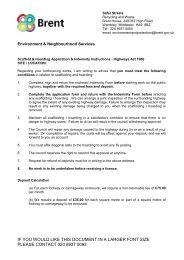


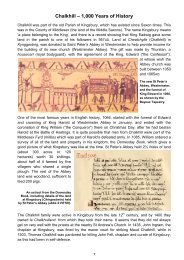
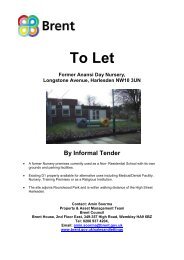
![0702012-khat[1] - Brent Council](https://img.yumpu.com/11457346/1/184x260/0702012-khat1-brent-council.jpg?quality=85)
